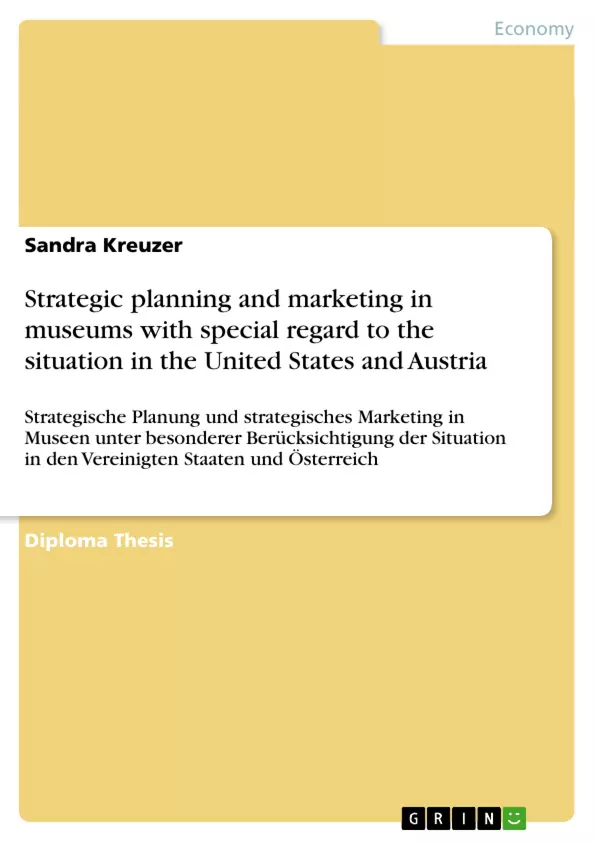The United States has been the leading innovator regarding the application of strategic planning and marketing principles to museums. These developments are becoming more and more important for managers of Austrian museums. Due to a continuous decline in public funds and growing competition for this decreasing pool of money it will be crucial for Austrian museums to get more access to private money sources. Consequently, they need to provide more public-oriented benefits that are not available elsewhere. It will be more important for Austrian museums to secure a high-quality service level and a positive image.
One can ask, of course, if this shift of responsibility from the public towards the private sector is desirable in Austria where only few large private money sources are available. In order to raise the basic funds for the famous Austrian museums it will always be necessary to pool the money of a large number of individuals, in other words, to raise funds through taxes. That is why the question of whether Austrian museums are considered to be effective must be asked. That is, do they provide essential and up-to-date services for the people who fund them? A further question that needs to be answered is whether the services could be upgraded and extended to a broader audience with the help of sophisticated marketing techniques.
It is astonishing that, especially in Austria, money and marketing are still considered dirty words in connection with museums and particularly in connection with art museums. A lot of people might be disillusioned by the fact that the effective and efficient use of money is a means to the end of creative expression and artistic communication. Michelangelo, for example, was an entrepreneur who sold his artworks for a profit. Rembrandt had a studio and employed other artists.
These conditions make a comparison between the status quo in the United States and the changing situation in Austria very interesting. In 2003, the famous marketing guru Philip Kotler wrote a book about the strategic marketing process in museums, and only recently, the Österreichisches Bundesministerium für Bildung, Wissenschaft und Kultur (BM BWK), which is the Austrian Federal Ministry of Culture, Education and Research, has publicized a study on the profile, positioning and marketing performance of the federal museums. Therefore it is clear that these issues are subjects of current debate – not only within the museum community.
Inhaltsverzeichnis (Table of Contents)
- Introduction
- Definitions
- Strategic planning
- Strategic marketing
- Museum
- Museum sector
- Scope and structure
- The museum as a non-profit institution
- The museum as a public institution
- Financial resources
- General remarks
- Public funding
- Private funding
- Competition
- Range of stakeholders
- Strategic planning process
- Strategic marketing process
- Conclusion
Zielsetzung und Themenschwerpunkte (Objectives and Key Themes)
This work examines strategic planning and marketing within the museum sector, focusing on the specific situations in the United States and Austria. The study aims to provide a comprehensive overview of the challenges and opportunities facing museums in these two countries, with a particular emphasis on the unique characteristics of each nation's museum landscape.
- Strategic planning in museums
- Strategic marketing in museums
- Financial resources and funding models for museums
- Competition and the role of stakeholders in the museum sector
- Comparative analysis of museum practices in the US and Austria
Zusammenfassung der Kapitel (Chapter Summaries)
The early chapters delve into definitions and the museum sector's broader context. This includes discussions of the museum as a non-profit institution, financial resources, and the diverse range of stakeholders involved. The text then explores the strategic planning process, encompassing SWOT analysis, mission formulation, organizational objectives, and performance evaluation. A detailed look at the strategic marketing process follows, encompassing market research, segmentation, targeting, positioning, and a range of marketing mix strategies. The final chapter focuses on the unique features and challenges of the museum sector in the United States and Austria.
Schlüsselwörter (Keywords)
This work focuses on the key concepts of strategic planning, strategic marketing, and museum management, specifically within the contexts of the United States and Austria. The text explores financial resources, funding models, and the impact of competition and stakeholder dynamics on the museum sector. Key themes include non-profit management, museum development, cultural institutions, and cross-cultural comparisons.
- Citation du texte
- Mag. Sandra Kreuzer (Auteur), 2005, Strategic planning and marketing in museums with special regard to the situation in the United States and Austria, Munich, GRIN Verlag, https://www.grin.com/document/135884



